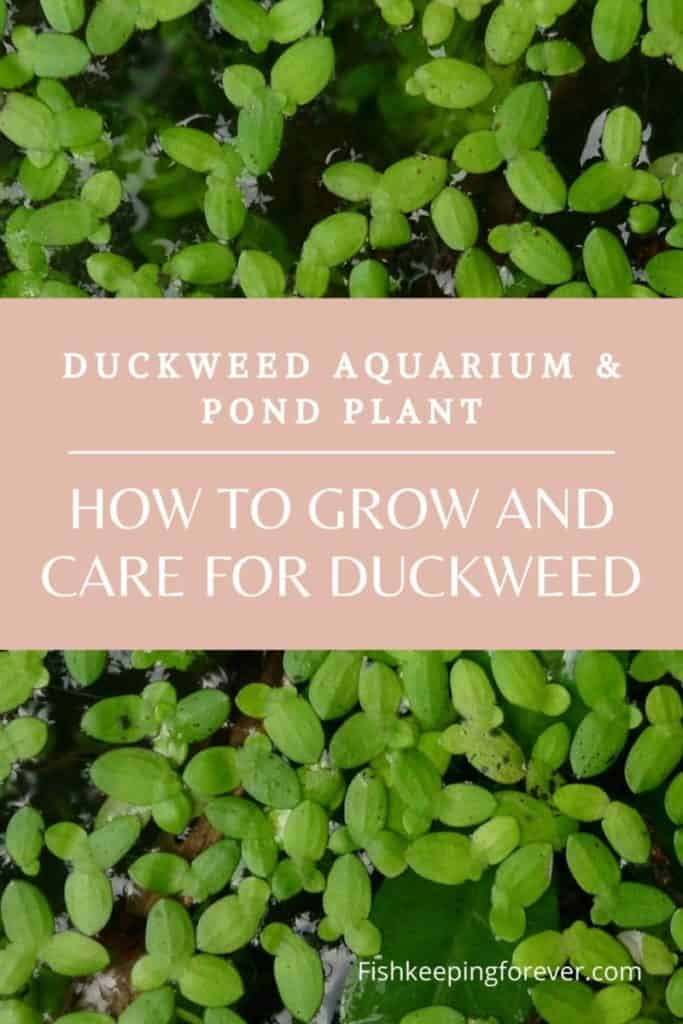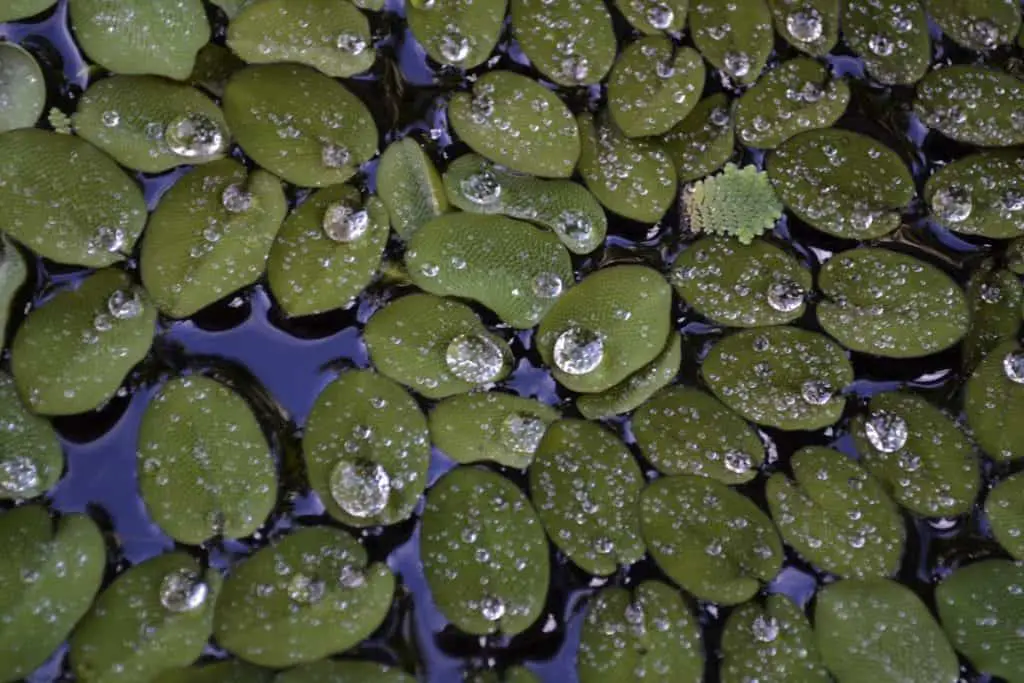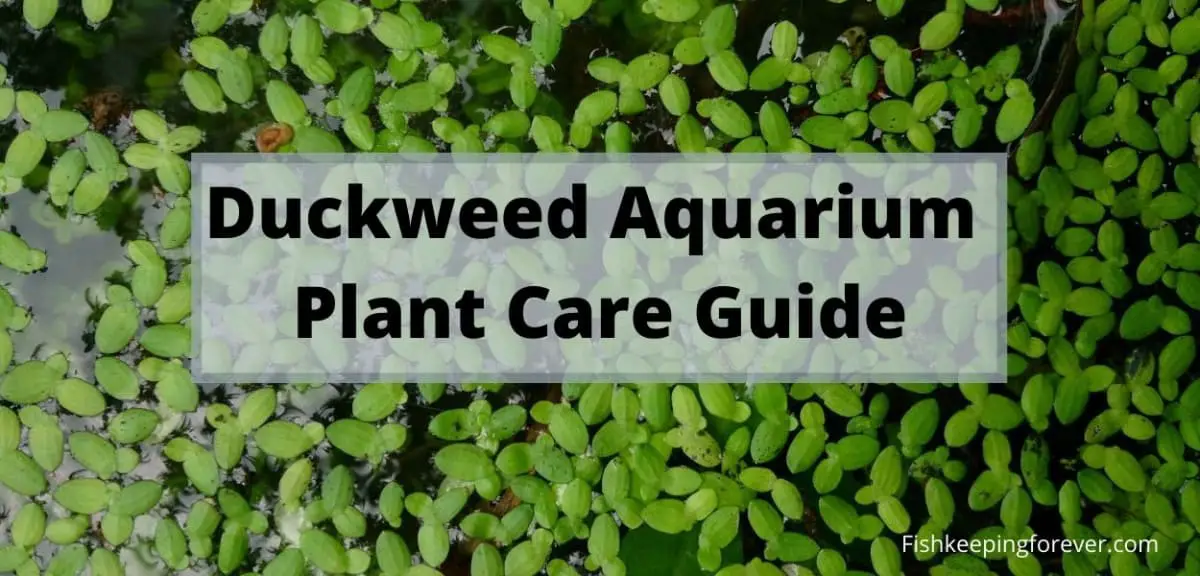Duckweed is a fast-spreading aquatic plant that was originally used by farmers to feed their ducks and fish. There are over 40 species; 9 of which are native to North America, with Lemna Minor being the most commonly found. Because of their size, tiny, it is difficult to distinguish which species you may have, although stem size and number of roots can help.
Ideal for people who are not exactly green-fingered, Duckweed is hardy and can survive in the most extreme of temperatures and climates. It does, however, thrive best in still waters with decaying organic matter which provides all the nutrients it needs. Duckweed is commonly thought of as the Marmite (Vegemite) of the aquatic world as fishkeepers either love it or hate it!

Table of Contents
Useful Information
- Scientific Name: Lemnoidae
- Family Name: Lemnaceae within Araceae family
- Common Name: Duckweed, Bayroot, Water Lens
- Origin: Africa, Asia, Europe, North America
- Color: Light green (vibrant)
- Size: Maximum of 0.8 inches long
- Growth Rate: Exponential in good conditions
- Care Level: Easy
- Lighting: High
- Water Conditions: pH 5 to 9, 42 to 91F. Quiet water, nutrient-rich
- Minimum Tank Size: 2 gallons (1 inch of water)
- Supplements: Fertilizers such as manure and mineral supplements
- Placement: Floating on or just below the surface
- Propagation: Very fast
- Compatibility: Carnivorous fish (herbivores will/may eat)
Duckweed Appearance
Duckweed is a small and free-floating aquatic perennial that combines to create a carpet across the surface of the water. It is a vibrant light green color and flowers producing small fruits, each containing up to five seeds. Each plant is single, rounded, has a leaf-like body and usually no bigger than 0.5 centimeters (1/4 inch) in size.
Made up of a simple structure, Duckweed lacks any obvious stem or leaf. Rather the greater part is made up of a small thallus or frond structure with air pockets that allow it to float. Several species will only be seen on the bottom of a pond during winter when the weather is too cold, only returning to the surface in the spring. Duckweed will remain green all year round.

Benefits Of Having Duckweed In Your Pond/Aquarium
For most aquarists live plants are preferable to artificial as they come with a good range of benefits. Duckweed is no different in this regard and has several positive attributes:
Algae Growth Prevention
Any pond or aquarium keeper, for that matter, will know what an issue algae can be when it takes hold. It can not only be difficult to eradicate but it is also aesthetically displeasing too.
Having Duckweed, however, can be a massive help in the battle against algae. This is due to the fact that this plant grows rapidly and uses up minerals such as nitrogen and phosphates that algae would otherwise feed on. It also, as a blanketing species, blocks the necessary sunlight for algae to bloom.
Aesthetic Benefits
Adding Duckweed to your pond/aquarium goes above and beyond the simple addition of adding some attractive greenery. Duckweed can also be used, due to its blanket-like qualities, as a disguise for eyesores. It can blend marginal planting baskets into your pond’s surroundings and be used as surface cover to hide pumps and other equipment beneath.
Water Evaporation Reduction
As you may have noticed already the water in your aquarium or pond evaporates a lot quicker during hot and sunny weather than it does when it is colder and wet. Duckweed can help with this as it lays a blanket over the surface of the water and stops some of the heat from getting through. In turn, the water is then cooler than it would have been without Duckweed and evaporation is lessened.
Duckweed: Features in our 21 Most Popular Aquarium and Pond plant Guide. Click here to read the article.
Water Quality Monitoring
Though this is still in the theoretical stage it is believed that Duckweed could be used to monitor the health of your pond or aquarium. The thinking is that the length of the root is directly related to the number of nutrients in your water. Hence, the longer the Duckweed root, the healthier the water is.
Water Purification
Thanks to a process known as bioremediation, which Duckweed can perform, this plant can absorb excess nitrogen and phosphates. It also captures toxins and odors which aid in controlling the development of algae.
Bioremediation is a process that is used to treat contaminated media, including water, soil, and subsurface material. It does this by altering environmental conditions to stimulate growth of micro-organisms and degrade the target pollutants.
As an added bonus Duckweed is a far less expensive and more sustainable method of bioremediation than other alternatives.
Fishy Benefits
There are two main benefits for your fish and other aquatic species from having Duckweed in your pond or aquarium. These are:
- It provides shelter for those fish who may like a shady spot or feel the need to hide.
- It can be used as the main food source, due to high protein content, for fish such as Koi, Tilapia, and Goldfish.
Problems With Having Duckweed In Your Pond/Aquarium
As previously mentioned Duckweed is an incredibly rapid growing plant that can double in size every two to three days in optimal conditions. In fact, it is estimated that in just 60 days it could cover a 30-hectare area.
This, of course, is fantastic growth if you are looking for large coverage quickly, but, you should also be aware that this rapid spreading can cause problems. After all, ponds and aquariums need good surface oxygen exchange and Duckweed can prevent this. It goes without saying, I think, that without enough oxygen your fish and other plant life will suffer.
It is also worth noting that Duckweed is classed as an invasive plant due to the rapid growth, and also that it is very easily accidentally introduced to ponds and sometimes aquariums. This can come in the form of it being present with newly introduced plant purchases, and also on the feet of birds and aquatic species visiting your pond. Once introduced to a pond or aquarium it is incredibly hard to eradicate and it will cling to anything in your pond/aquarium that it touches.
Is Duckweed Best For Ponds, Aquariums, Or Both?
Duckweed can survive and thrive in a wide variety of settings and conditions. It does, however, still have its preferences and limits.
Aquarium/Pond Size
Duckweed will grow and thrive in water as shallow as just one inch and up to around 20 inches. That is not to say that it will not grow in water any deeper than this, but it will not thrive in the same way. This makes Duckweed perhaps not the best plant to choose for deeper ponds, such as those that house species like Koi, or aquariums that are tall rather than wide.
Duckweed is perfect for Small Container and Patio ponds.
Water Conditions
The first consideration when contemplating the addition of Duckweed to an aquarium or pond is that most species can only survive in freshwater. Lemna Minor is the exception to this with the ability to thrive in sodium chloride levels of 0.5 to 2.5%.
Secondly, Duckweed does not enjoy water movement at all. It thrives best in still waters where it can form a carpet and not get pushed around. This means that aquariums with rapid water surface movement may not be the ideal location for placing Duckweed unless you can cordon off a still area for it.
Finally, optimum pH levels for Duckweed would be between 5 and 9 with 6.5 to 7.5 being the ideal. Water temperature should be in the range of 42 to 91F. Growth will slow if the temperature drops below 68 or goes above 86, and Duckweed will drop to the bottom of the aquarium/pond if the temperature goes to low. If this happens, don’t worry, Duckweed will come back to the surface and continue to thrive when the temperature rises back up.
Lighting Requirements
By far and away, Duckweed prefers direct and natural light as it naturally grows in open waters with very little shade. This makes it ideal for ponds that benefit from the sun’s light all day, and also aquariums that have been set up in windows. Be aware, however, that direct light can cause water evaporation especially if your Duckweed does not cover the majority of the water surface. If this happens you will need to ensure that you top up your aquarium/ponds water level frequently.
Artificial lighting can also be used on aquariums and should be hung 12 to 20 inches above the surface. LED lighting is preferential for this task as incandescent light bulbs use a large amount of infrared energy and can overheat the plant.
Substrate Needs
As a floating plant Duckweed does not require any substrate to embed its roots into. However, that said, a healthy aquarium/pond is one that is full of nutrients as nutrients will help Duckweed do well.
In order to maintain a healthy ecosystem in an aquarium/pond lower level plants should be included. These will need a substrate for them to root themselves into and therefore a substrate should be used.
Caring For Duckweed
Duckweed is incredibly easy to grow and care for. In fact, it is easier to grow than it is to stop it growing. Simply place the plant on the surface of the water and it will pretty much take care of itself.
It is, however, regardless of the ease of care, worth noting a few things in regards to Duckweed. For example, Duckweed can easily become entangled in your filter and clog it up and therefore placement of your filter or Duckweed is important.
Avoid clogging by either placing your filter flow around four inches below the surface or placing your Duckweed within an enclosed ring. A ring can be easily made from a floating tube connected at the ends. This can then be floated in your aquarium/pond and the Duckweed placed within.
Despite the ease of care, Duckweed is also not infallible. It may grow and thrive in most water conditions but they can fall below standard. You will know this is the case if your Duckweed starts to turn white and discontinues growing. If this happens you should check your water quality and the environment as they will have definitely fallen below what is healthy.
Propagation/Reproduction
Duckweed is a perennial aquatic plant that will live for over two years and doesn’t require any help in reproducing prolifically. It is an adventitious species that reproduces and divides asexually, cloning itself over and over, just like single-celled organisms do.
When they mature, these clones break off and form a new plant. In a warm environment and within a short time, just two weeks, they can produce up to 17,500 new plants. The flowers of the Duckweed play no role in its reproductive process, unless like the sun which accelerates it.
Controlling Duckweed Growth
Whilst rapid growth of Duckweed may be what some aquarists desire, it could also be scary to some and a tad unwanted. Do not worry, however, if this is the case for you as options exist to keep this plant under control. It should be noted that ‘out of control’ is far more likely to occur in a pond than it is in an aquarium, but it still can happen.
The most simple and quick method of controlling Duckweed is to scoop out excess growth from the aquarium or pond. This should be done if the Duckweed is covering more than half of the pond/ aquarium surface or when it has grown enough for you. You do not need to get rid of this Duckweed entirely, rather, you can place it in the freezer and keep it for up to three months for future use.
You can also use chemicals to control the growth of Duckweed. However, it is best to take expert advice before using any herbicide, especially if you’ve never used them before. Potential herbicides include:
- Carfentrazone
- Fluridone (slow-acting)
- Flumioxazin (young plants)
- Diquat
- Penoxsulam (no adverse effect on most animals)
Where To Get Duckweed From
Duckweed is commonly available in most pet stores, specialist aquarium retailers, online at sites such as Amazon, and from garden centers. It is inexpensive with a cup costing as little as $10. Because it is rapidly growing it is best to only purchase it in small amounts. You should also try to get one of the varieties that is grown close to your home.
You can also source Duckweed from local ponds and natural bodies of water close to you. Here’s how to harvest it:
- Fill a container with water and Duckweed from the pond.
- Cover the container to prevent splashing and protect it whilst taking it home.
- Limit yourself to around 50 to 100 pods so as not to overcrowd your pond/aquarium.
Adding Duckweed To Your Aquarium
Bear in mind when adding Duckweed to your aquarium/pond that it can be quite delicate to the touch. Handle with care and only add healthy specimens.
Duckweed From Mother Nature
To avoid any contamination you should always disinfect Duckweed that you have harvested from a local source. To do this add 1 teaspoon of bleach or potassium permanganate to 11 gallons of water and soak.
Duckweed From A Store Or Garden Center
Place your Duckweed into a 12 to 14-inch tray and fill it with tap or freshwater from a local pond. Make sure these plants get at least 10 hours of sunlight/natural daylight for at least a week. Check the tray every day and remove any damaged plants. When you notice the plants beginning to spread, add them to your aquarium.
Duckweed Compatibility
Duckweed is compatible with most small fish but may be devoured by herbivorous species and some cichlids. This is not necessarily, however, a bad thing since Duckweed is full of nutrients and protein and the snacking on it may help to keep it under growth control. Carnivorous fish will love Duckweed as they can keep cool under the shade of it, and if necessary hide from the more raucous amongst them.
When it comes to other plants, however, you may need to be a little careful. Duckweed and algae, for example, are naturally competitive with some algae such as red or blue-green being toxic to Duckweed. You may also find that some plants which need rooting at the bottom do not like the shade that Duckweed places them in.
Interesting Duckweed Facts
- Duckweed is believed to be the smallest flowering plant in existence.
- Duckweed is on the red list of endangered species in Switzerland.
- Duckweed contains more protein than soybeans and could be a significant potential food source.
- Duckweed is already eaten in some parts of South Asia. It is reported to taste like sweet cabbage.
- Best Aquarium Plant Substrate Review 2022
- 18 Benefits of Marimo Balls ( How many per Gallon? )
- 11 Best Plants for Betta fish
- Top 7 Best plants for baby fish
- 9 Best Plants for Guppies ( Freshwater Aquarium Plants )

I have been working in the tropical fish industry for over 30 years now and I’m still learning. Everyday is a school day in this hobby. In my spare time I play golf very badly!


